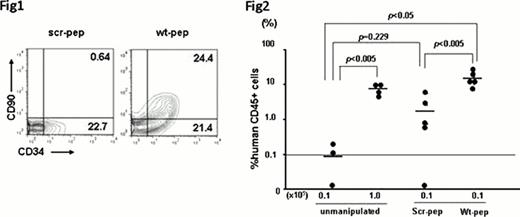Abstract
Abstract 2337
The nucleosome remodeling and deacetylase (NuRD) complex is involved in gene repression and normal hematopoiesis. In embryonic stem (ES) cells, NuRD complex directly maintains the self-renewal from lineage commitment. Murine models with defects in NuRD complex present with increased hematopoietic stem/progenitor cells (HSPCs). Several transcriptional factors (TFs), such as SALL4, FOG1, BCL11A, BCL11B, ZNF521 use a conservative 12 amino acid domain to recruit NuRD components for targeted gene repression. In this study, we plan to test the hypothesis that by blocking the interaction between NuRD and its TFs, we can phenocopy its knockdown effects on human HSPC. Human cord blood (CB) CD34+ cells were purified, and treated with peptide with the NuRD interacting sequences (wt-pep) or its controls mutant peptide (mut-pep) or scramble peptide (scr-pep). In vitro and in vivo assays were performed to evaluate whether wt-pep treatment can maintain or expand human cord blood HSPCs, which were further characterized as CD34+CD90+ and CD34+CD38-CD90+ sub-population with known repopulating potential after ex vivo culture.
First we observed wt-pep treated CB CD34+ (1×104) cultures with cytokines (SCF, Flt3 ligand, IL-3 and IL-6) yielded 10.6 times greater numbers of CD34+CD90+ cells (Fig 1) and 19.3 times greater numbers of CD34+CD38-CD90+ as compared to the cultures containing cytokines with scr-pep after 6 days of culture (p<0.05). Colony formation assay demonstrated wt-pep treated cells gave mainly rise to large colonies, while scr-pep treated cells generated high proportion of small colonies, 8 days after plating (p<0.05). Treatment of CB CD34+ cells with wt-pep resulted in an increase in total colony-forming cell (CFC) content compared to other control groups, 14 days after plating (p<0.005).
Then, to determine the most contributed to populations, Lin-CD34+CD38+CD90±, Lin-CD34+CD38-CD90± populations were fractionally sorted and treated with wt-pep. While the expansion rate of Lin-CD34+CD38+CD90± were too low to evaluate, wt-pep treated Lin-CD34+CD38-CD90+ and Lin-CD34+CD38-CD90- cells gave rise to 79.3% and 52.7% of CD34+CD90+ cells, respectively. In addition, Lin-CD34+CD38-CD90 + cells gave rise to much more CD34+CD38- population in wt-peptide treated cells as compared with scr-peptide treated cells (44.0%, 16.2% respectively) and almost all of these cells co-expressed CD90. These data suggested that both Lin-CD34+CD38-CD90± cells treated with wt-peptide could give rise to CD34+CD90+ as well as CD34+CD38-CD90+ cells. In addition, CD34+CD38-CD90+ cells seemed more contributed than CD34+CD38-CD90- cells for expansion of CD34+38-CD90+ cells.
Based on in vitro experiment results, we investigated immunodeficient (SCID) repopulating activity (SRA) to determine efficacy of wt-pep to HSPCs in vivo. We observed that mice transplanted the progeny of 1×104 CB CD34+ cells treated with wt-pep (n=5) had higher degree of human cell chimerism (0.38%) than that with scr-peptide (0%) (n=5) at 4 weeks in peripheral blood. The 8 weeks chimerism of wt-peptide treated progeny (13.6%; n=5) were greater than scr-peptide treated progeny (1.88%; n=5) (Fig 2; p < 0.005) and also greater than unmanipulated CD34+ cells (1×104) (0.09%; n=3) (Fig 2; p < 0.05). In addition, these mice (n=5) demonstrated that multilineage differentiation.
We further analyzed transcription levels of several HSPC related genes, which were compared between CB CD34+ cells treated with wt-peptide and scramble peptide. Significantly higher transcript levels were detected for HoxB4 (p < 0.05), GATA 2 (p < 0.05) and Evi1 (p < 0.05) and lower levels were detected for PTEN (p < 0.05) by real time quantitative RT-PCR in wt-peptide expanded cells as compared with scr-pep cultures.
Unlike embryonic stem cells, human HSPC can not be maintained ex vivo in a culture condition. The limit in source cells has greatly hampered the field of HSPC research. Optimizing ex vivo HSPC expansion culture condition not only can facilitate basic research on these cells, but also can be translated into clinical applications such as enhancement of CB engraftment and gene therapy. Our study demonstrates a novel peptide approach for ex vivo expansion of a unique CD34+CD90+ and CD34+CD38-CD90+ population with increased engraftment potential. Future studies will reveal whether the same condition can beapplied to HSPC culture for gene therapy.
No relevant conflicts of interest to declare.
Author notes
Asterisk with author names denotes non-ASH members.


This feature is available to Subscribers Only
Sign In or Create an Account Close Modal